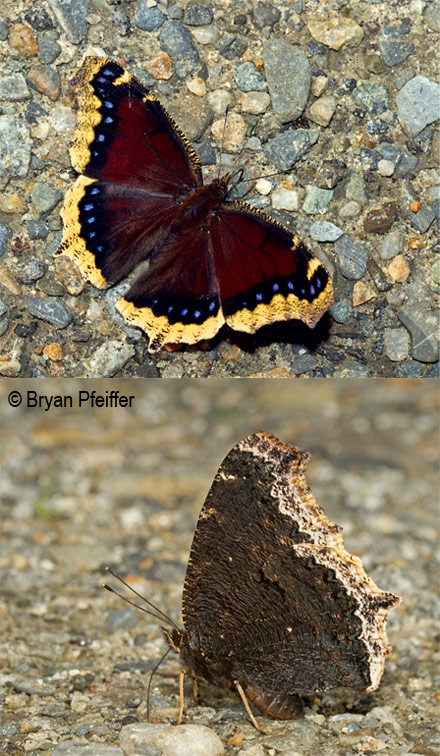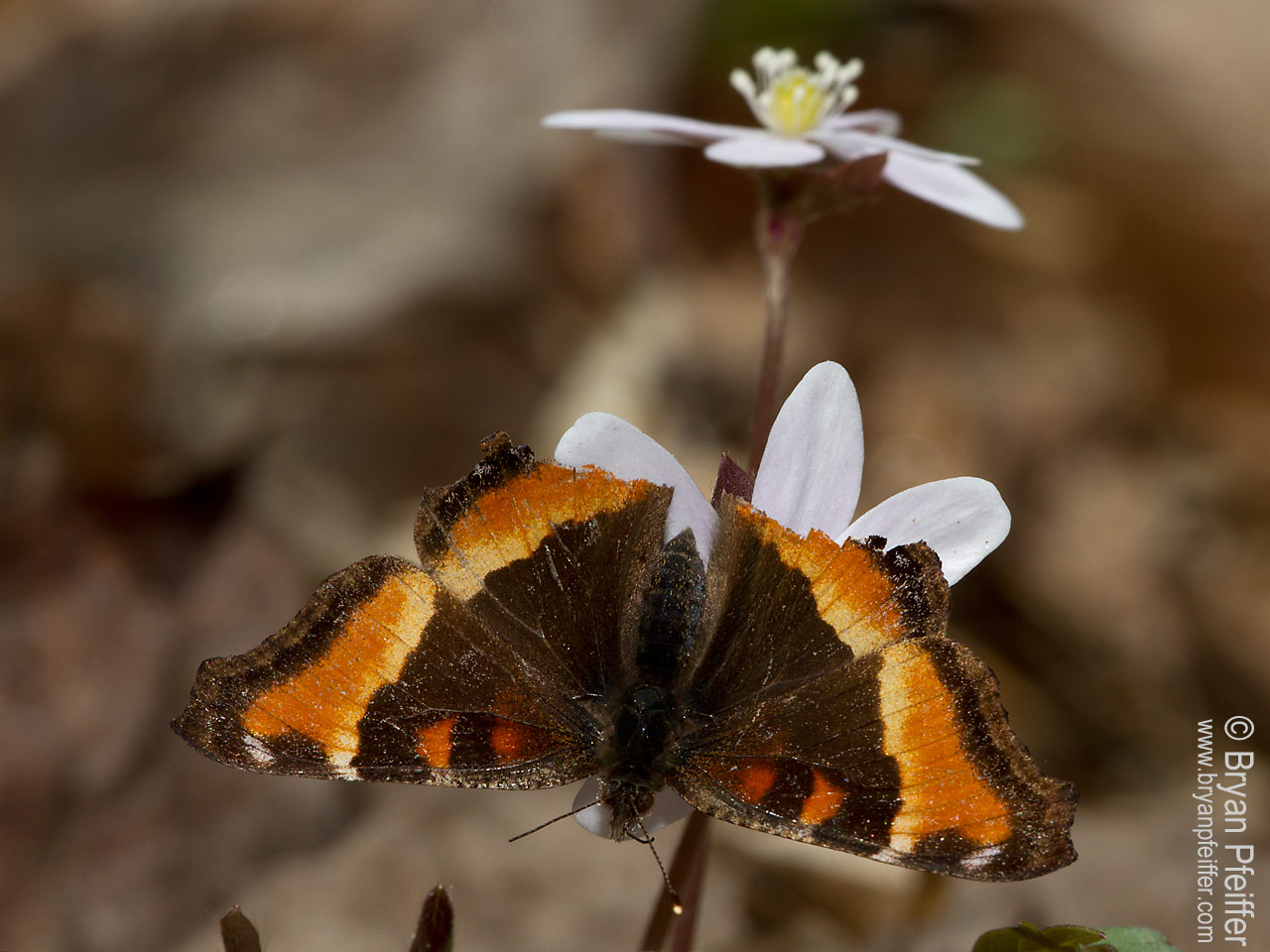The Last Butterfly

Mourning Cloak (Nymphalis antiopa)
By Bryan on November 5, 2013
From spring through fall, they flickered and fluttered among us – tiny flashes of red, orange, yellow and blue floating above hayfields and dancing in flower gardens: Spring Azures, Great Spangled Fritillaries, Red Admirals, Monarchs and more than a hundred other butterfly species here in New England. But soon, when the freeze finally reaches the warmest corners, the show will come to an end. Our last butterfly of the year, probably a Clouded Sulphur somewhere, will flutter no more. Winter will finish off the butterfly season.
Or so we’re told.
We often think of adult butterflies as the dominant phase in the life cycle of these insects. It is certainly the most elegant. After all, when you find your first Early Hairstreak of springtime, a prized butterfly about the size of a thumbnail, colored in cobalt blue and mint green, marked with little orange lightning bolts, you may want to quit your job, sell your house and become a lepidopterist. Adult butterflies surely get the glory, but most butterfly species live on the wing for only a week or two. Their primary role in life is to fly around and make more butterflies.
By November most of these butterflies are frolicking no more. A few species migrate, including the Monarch off to Mexico. Most of the rest stay close to home over the winter – but not in the adult stage. Depending on the species, they remain beneath the snow as an egg, caterpillar, or pupa. They employ a form of hibernation, called diapause, which sees them through winter in whatever form. By the following spring, each form will pick up where it left off in the progression from egg to caterpillar to pupa to adult
But even through the coldest months of winter some adult butterflies remain among us. You want audacity of hope? Find it in the select species that survive our winters as adults.
One of them is the Mourning Cloak, with chocolate brown wings that feature a row of blue jewels above buttery yellow wing edges. Mourning Cloaks are rather pugnacious butterflies. Males take a favorite perch and dart out at most anything that floats or wanders by, including people. The Mourning Cloak has a long life span by butterfly standards. By now, as the day length wanes and temperatures drop, this butterfly, like a black bear to a den, will seek out a cavity in which to pass the winter. On a crisp fall day, I once watched a Mourning Cloak crawl between the layers of a black fleece jacket hanging on my clothesline. But it will often select a more secure place: in fissures between tree bark or in a slot beneath a loose clapboard on a house.
Antifreeze is the key to wintertime butterfly survival. Over-wintering insects often build up reserves of lipids – body fat – and thicken their innards by manufacturing glycerol or similar compounds, which displace water and protect them from freezing temperatures. There in a cozy cavity the Mourning Cloak will wait, usually until the warm days of spring.

A Milbert’s Tortoiseshell visits Hepatica in Plainfield, Vermont.
But sometimes they launch before spring. On warm, sunny days of March, when the maple sap is running, some Mourning Cloaks take flight. And they won’t be alone. Marauding around in late March and April are small numbers of overwintering Milbert’s Tortoiseshells, sporting a shocking orange stripe across dark wings; Eastern Commas, which actually have a comma-shaped mark under their hind wings; and a few other enterprising species. Some rouse simply because their winter resting spots heat up fast in focused sunlight; others may find their way into – and fly within– garages or homes (where it’s tough to find a butterfly mate). The Vermont Butterfly Survey, which tracked butterfly abundance and distribution, has documented butterflies in flight in every month of the year except December, January and February.
But that may change. In Great Britain, entomologists and citizen-scientists, who have been watching and documenting butterflies for decades, have found that some are breaking records for early-season appearances. This and other research suggests that butterflies might be viewed as sensitive indicators of a warming planet.
For some people, butterflies in flight on Valentine’s Day in Vermont or New Hampshire might be a welcome sight. But in mid-February, I suspect most of us would rather see floating snowflakes than fluttering butterflies as part of winter. At the very least, it helps preserve the great anticipation of spring, when butterfly light will shine and flicker around us again.

Bryan, here’s another look at the same phenomenon, less elegantly written.
http://slatermuseum.blogspot.com/2011/04/butterflies-in-winter.html
I see these in the early spring before there’s a fleck of foliage out, and am always delightfully surprised. Thanks for the interesting and helpful information about them.
So kind of you, Carol. Thanks much! And I’m enjoying visits to Flower Hill Farm’s on-line presence: http://flowerhillfarm.blogspot.com/ Perhaps I’ll make it in the flesh some day (if only to escape the glowing screen). Thanks again!
Bryan, Your writing is beautiful and inspiring, greatly enhancing your stunning portrait of a Milbert’s Tortoiseshell. A lovely ‘closing’ to our butterfly season. I am thankful to Joshua for posting a link to this article over in the Mass. Butterfly Club’s Facebook page. Great to have found you and to read about your commitment to be ‘in’ nature more . . . rather than to be blogging etc. about nature . . . a trap many of us fall into.
Thank you!
Thanks, Bob. I’m jealous of your Red Admiral. I’ll bet it’ll be heading south out of Ontario fast!
Don’t know whether I like your photos or your evocative writing more
Bob Curry,
Ontario
ps. saw a Red Admiral today
Thanks, Martha! I did noticed Orange Sulphur still flying in Maine on Saturday.
Beautiful photoraphs, beautiful script. Made me feel nostalgic, for many things.